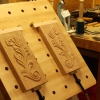The strop paste does the business: it's a fine abrasive that removes metal, sharpening the cutting edge and polishing. The abrasive is held to hard leather with a slightly soft medium (traditionally, tallow).
In this lesson I'll show you how I make my own strop paste. You only need a small amount! It lasts a very long time. I seem to get through a lot of this stuff because I'm always giving it away to students...
Abrasive: I use any and all fine metal abrasives, and they do want to be as fine as your fine sharpening benchstone. Suitable abrasives would be diamond paste, silver polish, Carborundum powder or grinding paste, and the blocks that are supplied for high-speed honing wheels.
Tallow: is rendered beef or mutton fat, processed from suet, and used in the past for candles and lead working. Tallow can be stored for much longer than suet but is harder to find today. I find suet an adequate substitute for tallow; when the abrasives are added the suet doesn't seem to go off or mouldy. However, do a web search for 'tallow' and you'll find plenty of suppliers.
Leather: thin, glued to plywood; rough side up. For more on strops, see my, Woodcarving Tools, Materials & Equipment, vol. 1

| 24 September 2022 14:59
William - I would use the hard side up (with the paste); we need this surface to be a flat as possible.
And, yes, give the finish a rub over with sandpaper to make sure the paste really binds.

| 22 December 2020 23:21
John - I had a strop with just valve-grinding paste for years and it worked well. The point is, you can throw in any fine abrasive that you've got. Over the years as you make more you'll find the ingredients will change...

| 22 December 2020 18:24
Chris,
Do I have to put all these ingredients in, or can I
just use say valve grinding paste and tallow?

| 22 September 2020 07:47
Michael - I can't visit the link from the UK for some reason, but it silicon carbide sounds is a good abrasive. Thing is, there's no real science to this; I just throw in all the fine abrasives I can find. The tallow is just there to bind them to the leather. I guess you could have too little abrasive but probably not too much - as long as it sticks!
The test of the strop will be whether you see dark forming on the paste because of metal being abraded from the carving tool. That means it's working. If you don't get much, then you need to boost the abrasive.

| 21 September 2020 20:03
Chris, would you also use the 2:1 tallow to abrasive ratio if you were using a silicon carbide powder?
Here's an example of what I was considering:
https://www.brownells.com/gunsmith-tools-supplies/metal-prep-coloring/abrasives/lapping-compounds/600-grit-silicon-carbide-sku080537600-579-2408.aspx?sku=080537600

| 08 November 2019 18:09
I really like the stropping paste I made as shown in this lesson.

| 12 February 2019 08:45
For all the vegetarians out there I can confirm that extra virgin coconut oil seems to be a good base. I don't know about longevity and whether it'll go rancid over time but 2 weeks in and it's holding up well.

| 24 December 2018 12:32
David - Yes, sometimes strop 'paste' is more of a block than a paste and, being hard, really won't grip onto the leather well. You should still be able to melt the Tiranti block with a little suet or tallow as I do to soften it, which is all you need to do.

| 23 December 2018 15:36
Chris: I bought Strop Paste from Tiranti, at the same time as a strop, but find it’s very hard and certainly impossible to spread on the leather the way you did in the video.
Any thoughts- or best to abandon and make my own as per your suggested method ?
Best regards
David

| 03 June 2017 08:06
David - The strop paste doesn't stick well to shiny leather, so the rougher side is better.
But, yes, you can roughen up the shiny side with sandpaper to get a better grip with the paste. Use sandpaper and finish with a stiff wire brush to get rid of any grit.

| 03 June 2017 05:26
Ha, right out of the gate I've screwed up the instructions. I made 5 strops today but I've got the smooth side of the leather up instead of the rough side. I don't suppose I could use sand paper to roughen it up? I guess the point of having the rough side up is so that the leather will absorb more paste?
thx!

| 02 April 2017 19:09
Azucena - I'd rub what you have into your leather; then put some heat on it, perhaps a hairdryer, to melt the paste. Strop well so the melted paste is pushed into the leather pores.
When cold, you'll find excess comes off to begin with but I think it will quickly settle down to work well.

| 02 April 2017 00:27
Chris - I just made a batch of stropping paste which I have noticed is a bit thicker than yours in the video. It's not crumbly at all, but definitely stiffer. Should I melt again and add more tallow or is it not that critical?
Azucena

| 01 April 2017 12:05
OK, sir, this may have gone over the edge. Except that the best strop I have takes three days to heat a mixture of green stropping compound and olive oil, spreading, scraping, renewing, heating, and eventually put to use. If it dries or flakes, rub in a bit more olive oil with your forefinger. It has lasted for years.
Getting down to basics, it sounds the same. Tallow is available via Amazon and other Web sites (expensive, of course), and this Jewish guy saw kosher tallow and chicken fat ("Schmaltz" to New Yorkers) for sale. How do you store excess? Freezing works with chicken fat. Surely not on a workshop shelf.
I'm not joking here: The next time I make chicken soup and skim off the fat, it gets strained hot in layers of cheesecloth, refrigerated, and thence into the strop paste. My grandmother, nay, all our grandmothers, would be proud!
I urge everyone to resist licking the tool's edge!

| 29 March 2017 18:07
Hello to everybody!
My update for "Stearic acid" that I mentioned at a previous message: do not spend time with that material, it becomes hard like rock as it cools down.
At least, now we know that it doesn't work for that job!
Best regards!

| 06 March 2017 09:57
Karen - Google search for 'valve lapping paste' or 'valve grinding paste' + Canada or wherever. (e.g. http://www.canadiantire.ca/en/pdp/powerbuilt-valve-lapping-compound-0253201p.html).
You may well fine 'coarse' and 'fine' rather than a specific grit, and often combined in a single package. Throw either/both into the mix. If it's coarse, it'll just mean fewer strokes to strop the edge.

| 04 March 2017 18:43
Just want to say thanks to all those who have mentioned the products they used to make paste and where to purchase them. Your information has aided me in refining mine. I'm still having trouble purchasing silicon carbide valve grinding paste that has 600 grit or a cutting compound. If you live in Canada or Northern USA and know of a product please mention it. Thanks to Sandy for the tip on mutton tallow.

| 27 February 2017 14:11
Chris I was not able to get the Atora product so I got beef fat from a butcher. Cut off any meat. Placed water in an old pot and approximately half a cup of shredded fat in a small jam jar. The fat is best used frozen, wait a few minutes after you take it from the freezer and then shred it on a metal grader. Messy. I boiled it until it rendered down as much as possible and strained it through a fine metal sieve. I added approx. 1 large tbsp. of silicon carbide valve grinding paste, 1/2 piece of jewellers rouge, 1-tbsp. of green honing compound, approx. 1 tbsp. of Autosol metal polish and let it boil to a liquid mush. Unable to get the cutting compound I did not add it but still looking for a local supplier. I let the mix cool. Some fat sits on top, I removed some not knowing exactly what to do and the rest I mixed in with the paste and ceiled it with a lid. The following day I spread it on my leather. So far it is working. I emphasize to have ventilation during the process and wear gloves when touching the product. I guessed at the measurements by the amount Chris used in his demonstration. If you can cook you can make paste.

| 27 February 2017 07:26
Angelos - I know that suet is 'rendered' animal fat and that tallow is a further rendering of suet but stearic acid is new to my carving experience. A quick search online told me it was 'made by extraction from tallow' so I suppose it's just further on in the rendering process.
Tallow is preferred to suet as its purity means it won't go rancid and, at the end of the day, is only the medium to hold the abrasive to the leather. I suspect stearic acid would do the job as well as tallow and if it's more ready available than tallow then you are into something new here. But, as I said, stearic acid and using it is new to me. I hope someone can follow this up!

| 26 February 2017 22:28
Hello Chris and everybody!
I would like to ask: Tallow or suet is the same thing as "Stearic acid" that is used in candle making, for example?

| 13 February 2017 15:24
Karen - The simplest thing, since tallow is a not edible and not readily to hand these days, is to put 'Tallow' into Wikipedia to find out all about it, and 'Buy Tallow Canada' into Google to find somewhere to buy it.
Again, and I love the internet for this sort of specialised thing, search for 'Carborundum 600 grit and you should be able to find a source. It doesn't matter whether it's in powder form or paste for mixing with the tallow, and don't buy a lot: a little will last you a very long time!

| 12 February 2017 15:29
Chris the shredded tallow that you are using, could you provide more of what it says on the box as products in Canada go by different names? Is this product found in the freezer section of a grocery store? I wasn't sure if what I was looking at was the same thing and neither did the clerk. Carborundum powder is that found in a specialty store or can I purchase it at any hardware store? I had to order the jewellery's paste from out of town but what a difference, brought up a shine like grandmother's mirror, unbelievable! So thanks for that.

| 05 April 2016 00:33
Amazon uk sell tallow guys

| 01 April 2016 20:18
Thank you for your reply! Hopefully not stirring it enough is all that I did wrong. That probably accounts for the hardness of the paste as well.
Sincerely,
Liam
P.S. In case you're confused: I, Liam, am the carver; I am using my dad's, Brian's, account. (:

| 31 March 2016 08:07
Bert - You do want an abrasive on the strop: you ARE removing metal, even if in microns. I'd add the 600, which is somewhere about the translucent Arkansas stone and you won't need to strop as much as the finer abrasive. But throw some of that in anyway, it will help polish the metal.

| 31 March 2016 08:04
Liam (AKA Brian!) - My guess is that the suet separated from the abrasive when it cooled. You can warm it all up again, give it a good stir and apply it to the leather melted. When I first made my bench strop I was advised to put it under the grill (broiler) and melt the tallow/abrasive that I'd put on it; then to and work the mix into the leather as it cooled, wiping off excess until the strop 'settled down'. So you might try that? I don't use vegetable suet myself but I know carvers who do, successfully. At the end of the day, it's only a way of holding the abrasive to the hard leather.

| 29 March 2016 14:09
Brian, mine also has a hard consistency. I cut it with a spoon and then apply it on the strop with the fingers. It sitcks on the leather smoothly, so I guess this may not be a problem.

| 29 March 2016 01:33
If you had a choice between 600 grit or 1200 grit silicon carbide powder, which woul you suggest? Or mix half and half?

| 29 March 2016 00:38
Mr. Pye,
Forgot to mention this: I just remembered that the suet I purchased was vegetable suet, not 'the original,' as yours is. Is this possibly a reason for the white layer on top?
Thanks,
Liam

| 28 March 2016 20:45
Hello Mr. Pye,
This is Liam. I made a batch of strop paste about six months ago (a jam jar half-full). It took several tries to get a semi-decent consistency. But then I had a different problem: there was a whitish-colored layer of what I think was suet (about a quarter-inch thick) on the top after I let it dry. I was able to scrape the suet off, but I still have to reheat the abrasive in the microwave before I apply it to a strop. Any idea why this happened? I looked at the abrasive block I had used (jewler's rouge, I believe) and it seems very hard compared to the one in your video - I had to cut it with a sharp knife. Maybe this is why, and maybe I should try a softer block or something?
Your insight is much appreciated!
Thank you,
Liam Hedrick
P.S. The reason why I am asking this six months after making it, is because I just recently made some new strops and applied some strop paste, which gave me the thought to ask you for advice.

| 12 December 2015 07:38
Dena - Isn't this fun! It can only be the tallow that will make it softer: I would melt a measured amount of your block-like mixture with an additional, measured amount of tallow (say a third) and see what happens. In the end, you'll find a ratio that works when cold. Most people seem to make huge amounts of this strop paste but a small amount will last you a long time.

| 07 December 2015 16:14
Hi. Got my chisels and tried to make the strop paste. I used some red jewelers rouge (block), green abrasive block and the silicon carbide powder with the mutton tallow. After cooling it is not a paste and I can't get it out of the jar to put it on the leather. Perhaps it is because the silicon carbide paste when it came was not a paste, but rather a powder. I can re-melt, but what could I add at this point to make it spreadable consistancy?

| 15 August 2015 19:24
Andy - Ideally you want very thin, undressed leather, and you stick the soft, suede side down to the strop board. A lot of leather, especially when you salvage it, is 'dressed' - in other words hard and shiny - on one side, as you describe. That shiny surface stops the strop paste adhering to the leather so I do 'key in' this hard outer surface well with fine sandpaper before adding the paste. A cover is all I use to keep dirt and wood chips off the strop; I don't think a plastic bag is necessary unless you are storing the strop for a long time.

| 15 August 2015 06:09
Hello Chris; Just to confirm, I think of leather as hard shiny side and then soft suede side. The paste should be applied to the "suede" side? not the shiny, or have I got this wrong. The bench strop is protected by a piece of "cover leather" however should I store the slip strops in a sealed plastic bag to keep the "dirt/dust" off and retain a degree of moisture?

| 24 June 2014 16:05
Charles - Yes, that does sound odd! I've never done that, or heard of anyone else doing that, and I don't like the sound of sanding grit in my strop abrasive! I do periodically refresh the abrasive on the leather with a little more - everytime you wipe the blade after stropping you remove a tiny amount. That's all you need to do. Really!

| 22 June 2014 01:35
Hello Chris,
this may sound odd but a fellow in my carving class states that periodically one should sand the strop to remove the metal left behind from stropping a tool. This doesn't make sense to me what are your thoughts ? Thank you for sharing your expertise in the various areas of carving and tool preparation..
Charles

| 04 June 2014 16:34
Charles - A lot of leather is 'dressed', ie has one surface to which the paste won't stick well. You can glue the rough side to your wood and lightly sand over the dressed side to key in the paste. Generally the 'rough' side grabs the pastes better but you don't want the surface actually rough, ie lumpy - the flatter and harder the better. It's the abrasive that does the sharpening, not the leather itself, and your stones are always better at removing metal than the strop. Use the strop for polishing and quickly slicking up, and the stones for shaping and getting that edge in the first place.

| 03 June 2014 23:02
Hello Chris,
I tried the petroleum jelly with disappointing results. Concerning the leather I perceived that you said rough side up. Is there an advantage to not using a rough side on one strop and a smooth side on another or would that be redundant ? Would the rough side cut faster for shaping and the smooth side for finish / polish. Please advise.
Charles

| 21 April 2014 08:49
Paul - No harm is trying but I doubt toothpaste would be very effective. Carving tools are high carbon steel; headlight 'glass' is plastic... Still, some carvers use 'jeweller's rouge', which is actually a silver polish and silver's a lot softer than steel. Let us know!

| 20 April 2014 22:39
has anyone thought of using tooth paste as abrasive because you can use it to polish your headlights on your car when the get tarnish.

| 25 February 2014 21:31
Hello Charles.I could not find any tallow either.I just rub a little petro jelly in the leather and then rub on the abrasive Flexicut.I have been using it for about one year and does not appear to dry out.Its also probably cheaper than mixing it all together at the start.A pot of petro jelly pre mixed would last me about 100 years. Is there a problem after a while with the mix of petro jello and leather?

| 18 January 2014 15:31
Charles - Never heard of that. Only one way to find out. Let us know!

| 18 January 2014 03:10
Hello Chris,
Instead of tallow what if one were to use petroleum jelly as a vehicle to hold the abrasive on the strop ?

| 31 May 2013 08:12
William - Good going! The one thing to watch out for over a period of time in a well-stropped carving tool is the rounding of the bevel and thus a rising cutting angle. This is almost inevitable if the leather has any softness whatsoever, or just by tending to favour the edge not the heel as you strop. You can flatten a rounded bevel and thus lower the cutting angle quickly on a fine bench stone, stopping at the cutting edge, which, of coure doesn't need sharpening!

| 29 May 2013 20:24
Chris- Per your suggestion I assembled some abrasives. 4gr each 16-22micron, 3-6micron, 0-1micron 50% concentration diamond lapidary paste. 1 large-ish chunk of green chrome rouge (700grit) and a small chunk of Al oxide rouge (1200grit). I found a soap and cosmetics supplier on ebay and purchased 1/2# of beef tallow. It is very soft about like warm butter (I was a little worried about this). Put it all in a jar and melted it. I hand to put it in the refridgerator to get it to harden up. After a night in the fridge I took it to the shop and began experimenting. It has a consistancy of butter left out on the table and wow does it work! I stropped several types of steel, including an M2 HSS knife I made. I carved 56 round tenons for the slats on a rustic gate in doug fir, stropping every 20-30 minutes. I never resorted to another sharpening tool! After finishing I tried a couple of cuts across the grain in basswood with each knife, no real sign of edge degredation that I could tell. I will have to get out my microscope and study the edges to really see whats going on, but you were right the mixed particle sizes did seem to work better than single grit stropping. A much better solution than have 3 or 4 strops of each profile cluttering up the bench. Thanks, Bill

| 03 May 2013 16:58
William - I just throw into the mix whatever fine abrasive I can lay my hands on. I confess it's not well thought out, but seems to work just fine! About 600 grit as David mentions above or 6mu diamond paste give a good level of abrasive if you want to be accurate.

| 01 May 2013 04:29
Chris - I was wondering why you made a strop paste loaded with different grades of abrasive rather than individual strops with a single grade of abrasive on each?

| 04 December 2012 21:36
I've just purchased some tallow from a UK company called Cromwell Tools - www.cromwell.co.uk
the code for a 500g tub is MON5880262S. I've also located some 600 grit silicone carbide valve grinding paste from a company called Raizo -www.raizo.com. And finally, if your looking for a really good leather strop at a competitive price try www.the identitystore.co.uk. The code is IDL-STROP2. Hope this may of some help.

| 24 November 2012 20:21
I went to Amazon.com and was able to order the same suet that Chris uses in his video. it comes from a place in England. The cost was about $10.00 that included shipping, it took about 8 days to arrive!

| 04 October 2012 18:31
For those wanting real pure mutton tallow like Chris recommends, I found it on Amazon.com. There is one for $2.39 plus a slight shipping fee for a 1oz. jar. It is made by Eko. Just do a search for "Eko Mutton Tallow" and you will find several. I haven't as yet made a batch of stropping paste as I am still collecting all the other abrasives that I want to use in mine. I have some diamond paste, a small chunk of jeweler's red rouge (which I have had now for some 40 years), a hunk of Flexcut stuff, some other stuff that comes with the Beal Bowl Buffing System, and am waiting for a vintage tin of valve grinding powder. I figure that a little of this and a little of that along with the ounce of tallow will do the trick. I used to do a lot of leather carving in my youth and so I have quite a bit of different leathers to make a couple of nifty strops. Hope the Amazon tip helps, Sandy

| 08 August 2012 14:11
Peter - I don't think it's a temperature issue. The bain marie is just a way of melting and mixing everything together and the contents aren't that hot. I'd try upping the softer, suet ratio - perhaps what you found in Singapore is different from what we call 'suet' here - who knows? You can add carborundum powder (600grit) to keep the abrasive aspect high.

| 04 August 2012 21:56
I made a batch of using some Pfeil green polishing compound with a squirt of metal polish from a tube and what was available in Singapore, reduced fat vegetable suet. I may be pushing the boundaries of what can be used because the cold mixture is quite hard and certainly not the consistency of the red in you video. I was wondering therefore, what is the temperature of the mix in the video? Cheers, Peter

| 07 July 2012 19:45
I was having a hard time finding a commercial rendered suet. So I just asked the meat department at Publix if they had any seut. They gave me a couple of pounds of fat for free not to be confussed with fat free suet.
To render the suet I just sliced it up and laid it in a small( 2"X 9"sq.) covered pyrex casserole dish. Microwaved it 10 min. med.high then strained it through an old T-shirt and then another 10 min. and strained the additional suet. It's cooling in the freezer as I'm writting this. I've read that if I render it again it will get a little harder when cooled.
And for dinner I'll be making a Blueberry Pie.

| 04 May 2012 07:20
Richard - I've used vegetable 'suet' quite successfully.

| 03 May 2012 09:17
Is vegetable suet okay to use?

| 28 February 2012 18:23
Don - That's the sort of block you see in the video, designed for melting with a high-speed honing wheel. It will certainly be a good abrasive but my experience is that the dry, brittle nature of these blocks causes them to powder off the leather, which means frequent re-application onto the strop. The tallow/suet that I mix with these sorts of blocks makes the abrasive sticky and flexible on the leather; it stays in place despite the stropping. I can go years (literally) without re-applying my strop paste. I only make more because I give it away!

| 27 February 2012 21:20
For those who don't wish to make their own, I recommend "Yellowstone" put out by Herb Dunkle of Great Falls, Virginia, and available at a number of wood retailers. Its color is actually sort of pink or peach and goes goes on the leather black. Does a great job. I strop every tool used at the end of a carving session.